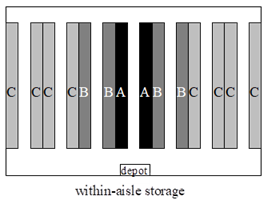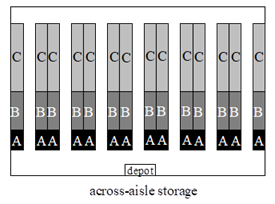Storage strategies
A storage strategy is a strategy by which you determine where to store your products. Roughly, two storage strategies can be distinguished. The first one is a random storage strategy. The other strategy is the ABC storage strategy. Both strategies will be discussed below.
Random storage strategy
Randomized storage is used if an item can be stored at any empty location in the warehouse. There is no specific location where the products have to be stored, but in practice this strategy usually means that when an item arrives at the warehouse it will be stored at the nearest appropriate warehouse location. This strategy is especially useful when the range of products is too large for the number of product locations. This means, that no determined locations have to be reserved for products that are to be received: any location will suit. By using a random storage strategy, less space is needed to store all products than in a situation in which the products can only be assigned to a certain pick location.
Since the locations of stored items vary, it is necessary to keep the order pickers well informed about where the products are stored.
ABC storage strategy
The other storage strategy is the ABC strategy. If you store your products with the use of this strategy, the products are subdivided into three categories. The grouping of the products into categories is based on the nature as well as the size of the products. Fast moving products (category A) preferably are stored at pick height (the height at which the products can be picked with the least effort) and at the front end of the warehouse. In this way, the distance between depot and pick location will be reduced to a minimum. Slow moving products (category B and C) are stored at the back. To maximize the efficiency of this strategy, it is necessary to change the division of products into categories if changes in demand are large. If some items of category B are ordered more frequently at a certain time, these products might be grouped into category A instead of B.
Category A accounts for products which turnover rate are high and the number of locations is rather small.
Category C exists of products which average storage time are much longer than the storage time of the so called A-products. These products need relatively much space in the warehouse.
Category B is in between category A and C, concerning turnover rate and space needed. With the help of these categories the warehouse is grouped into three zones in which just one category of products is stored.
Several authors have pointed out that considerable savings in the travel time by using the ABC storage strategy can be reached. For example Jarvis and McDowell (1991), Caron, Marchet and Perego (1998), Hausman, Schwarz and Graves (1976): if 3 categories are stored in one aisle, savings up to 60 percent can be realised, and Rosenblatt and Eynan (1989), who investigated the effects of the ABC storage strategy for warehouses with N categories, have written articles on this subject.
The layout of the division of the products into categories depends on the location of the depot. Since the depot is the starting point of the route, the A-category will be situated as near as possible to the depot. If the depot is located at the right side of the warehouse this leads to a layout with the A-zone at the right side.


To calculate total travel time the size of the zones have to be known, as well as the percentage of picks from these zones.

